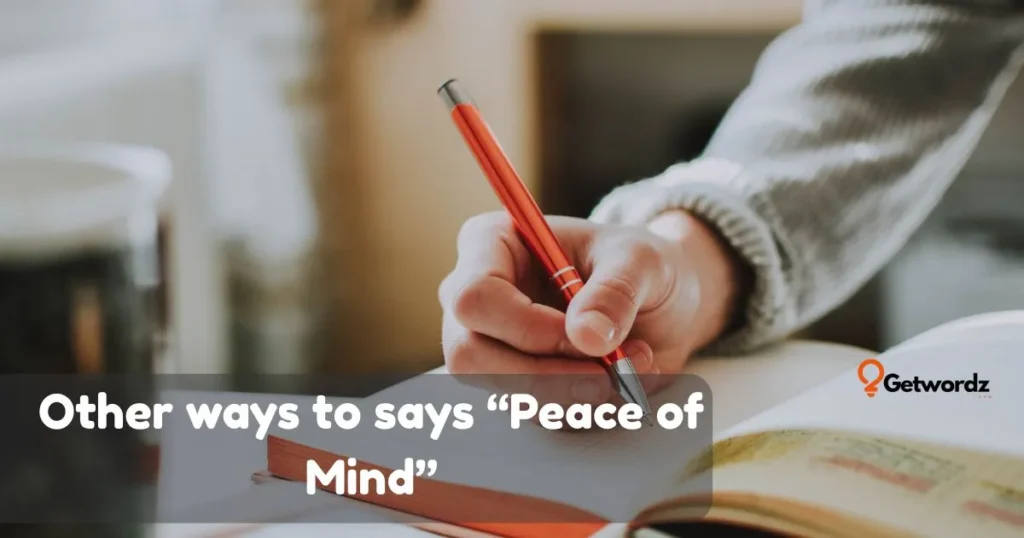Peace of Mind is more than just a phrase, it’s that calm, comforting feeling we crave when life feels overwhelming or uncertain. Whether it’s work stress, relationship worries, or everyday chaos, everyone searches for peace of mind as a way to find balance and emotional clarity.
But using the same phrase over and over can start to feel repetitive or lose its emotional impact, especially when you’re trying to express genuine comfort or reassurance.
That’s why this post dives into creative, thoughtful, and meaningful alternatives to saying peace of mind. You’ll discover different ways to express calmness, contentment, and inner balance, phrases that sound more natural and heartfelt in conversations, emails, or social posts.
Whether you’re talking to friends, family, colleagues, or your partner, these unique expressions will help you communicate comfort and positivity with sincerity.
As someone who values emotional connection and authentic communication, I’ve gathered these alternatives from real-life experiences and meaningful interactions. Each one offers a fresh way to express serenity and emotional security.
Ready to explore beautiful and better ways to say peace of mind? Let’s dive in and find the words that truly reflect your calm and confidence.
1. Inner Calm
Scenario: After a long, chaotic week, you finally sit down with a cup of tea and feel your thoughts quiet down. That soothing stillness is what people often mean when they talk about finding inner calm.
Explanation: Inner calm describes a deep sense of personal peace and balance. It’s a creative alternative to peace of mind that feels introspective and emotionally grounded, perfect for self-growth or mindfulness contexts.
Examples:
- “Meditation helps me restore my inner calm every morning.”
- “No matter what happens, she manages to maintain her inner calm.”
- “Nature walks are my favorite way to find inner calm after work.”
Why It Works: The phrase sounds thoughtful and personal. It connects emotional balance with mindfulness, making it a strong alternative to peace of mind that resonates across lifestyle and wellness topics.
2. Sense of Serenity
Scenario: You’re watching the sunset after a busy day, feeling a wave of quiet satisfaction. That moment perfectly captures a sense of serenity.
Explanation: This phrase conveys tranquility and emotional stillness. It’s an elegant, expressive alternative to peace of mind that works well in reflective or spiritual writing.
Examples:
- “Spending time near the ocean always brings me a sense of serenity.”
- “Her words carried a sense of serenity that comforted everyone.”
- “Early mornings give me a sense of serenity before the rush begins.”
Why It Works: It feels poetic and genuine. The phrase adds emotional depth and warmth while keeping communication natural and calm.
3. Emotional Balance
Scenario: When life feels overwhelming, you try to focus on what matters and let go of what you can’t control. That’s practicing emotional balance.
Explanation: Emotional balance means maintaining a stable state of mind. It’s a powerful yet professional variation of peace of mind, often used in wellness, leadership, and self-care discussions.
Examples:
- “Journaling daily helps me build emotional balance.”
- “She handled the news with surprising emotional balance.”
- “Work-life harmony starts with emotional balance.”
Why It Works: It blends mental wellness with self-awareness, offering clarity and composure. The phrase is ideal for modern readers focused on mindfulness and personal growth.
4. State of Tranquility
Scenario: You’re lying in a hammock, listening to gentle rain. Everything feels quiet and still, that’s a state of tranquility.
Explanation: A state of tranquility describes complete calmness and relaxation. It’s a descriptive and peaceful alternative to peace of mind, perfect for lifestyle and wellness content.
Examples:
- “The sound of waves always puts me in a state of tranquility.”
- “Reading before bed creates a state of tranquility.”
- “Her smile brings a state of tranquility to any room.”
Why It Works: The phrase paints a vivid mental image and appeals to readers seeking calm in everyday life. It’s elegant yet relatable.
5. Mental Clarity
Scenario: After a good night’s rest, your thoughts feel organized and light. That refreshing feeling is mental clarity.
Explanation: Mental clarity represents focused thinking and emotional calm. It’s a more practical and modern way to express peace of mind.
Examples:
- “Morning walks give me the mental clarity to start my day.”
- “I find mental clarity when I unplug from social media.”
- “Good sleep and hydration are essential for mental clarity.”
Why It Works: It combines serenity with focus. This phrase suits productivity, health, and self-improvement content, making it versatile for broad audiences.
6. Restful Mind
Scenario: You finally shut down your laptop and take a deep breath before bed. That light, calm sensation reflects a restful mind.
Explanation: A restful mind means a peaceful, relaxed mental state free from stress. It’s a comforting and casual alternative to peace of mind.
Examples:
- “A good book before bed always gives me a restful mind.”
- “Meditation helps me achieve a restful mind at night.”
- “You can’t make clear decisions without a restful mind.”
Why It Works: It’s simple, warm, and emotionally soothing. The phrase feels personal, making it relatable in daily life contexts.
7. Calm Within
Scenario: Even when plans go wrong, you stay composed instead of panicking. That’s your calmness at work.
Explanation: Calm within symbolizes internal peace and control despite outer chaos. It’s a poetic, mindful twist on peace of mind.
Examples:
- “I try to find calm during stressful meetings.”
- “Her calm within inspires others to slow down.”
- “You can’t control life, but you can nurture calm within.”
Why It Works: It’s introspective and emotionally strong, perfect for motivational or wellness writing.
8. Sense of Relief
Scenario: You finally receive good news after days of worry , that deep exhale is your sense of relief.
Explanation: This phrase expresses the release of tension after anxiety. It’s a relatable, everyday alternative to peace of mind.
Examples:
- “Hearing the test results gave me a sense of relief.”
- “It’s such a sense of relief to finish that project.”
- “Their safe arrival brought us all a sense of relief.”
Why It Works: It’s genuine and easy to connect with emotionally, making it ideal for casual or empathetic writing.
Read More: 30 Other Ways To Say “Please Find Attached” Examples!
9. Feeling Centered
Scenario: You’ve been juggling too much, but after a quiet moment of reflection, you start feeling centered again.
Explanation: Feeling centered means being emotionally grounded and focused. It’s a friendly, conversational alternative to peace of mind.
Examples:
- “After yoga, I feel centered and ready for the day.”
- “She’s been working on feeling centered through journaling.”
- “Meditation helps me stay feeling centered under pressure.”
Why It Works: It’s warm, inclusive, and fits both personal and professional tones.
10. Quiet Confidence
Scenario: You enter a meeting fully prepared but calm, not boastful , that’s quiet confidence.
Explanation: This phrase combines inner peace with self-assurance. It’s a creative alternative to peace of mind that focuses on composure.
Examples:
- “He handled the challenge with quiet confidence.”
- “Quiet confidence is more powerful than loud words.”
- “Her quiet confidence makes people trust her instantly.”
Why It Works: It links emotional calm with confidence, appealing to leadership and mindset audiences.
11. Emotional Stillness
Scenario: You’re sitting quietly after a heated discussion, choosing not to react but to reflect. That gentle pause reflects emotional stillness.
Explanation: Emotional stillness means being calm and composed even when emotions run high. It’s a mindful and elegant alternative to peace of mind that emphasizes emotional control and maturity.
Examples:
- “Meditation helps me find emotional stillness during tough times.”
- “Her emotional stillness in crisis moments inspires others.”
- “True strength comes from emotional stillness, not reaction.”
Why It Works: This phrase conveys inner strength and mindfulness. It resonates deeply with readers seeking emotional growth and calm under pressure.
12. Content Heart
Scenario: You’ve achieved what truly matters , love, health, and purpose , and feel quietly fulfilled. That’s having a content heart.
Explanation: Content heart is a warm, emotional way to express gratitude and satisfaction. It’s a personal, poetic variation of peace of mind.
Examples:
- “Spending time with family gives me a content heart.”
- “After years of chasing more, I finally have a content heart.”
- “A content heart is the key to lasting happiness.”
Why It Works: It’s intimate and genuine, making it perfect for personal reflections, gratitude posts, or emotional writing.
13. Mental Ease
Scenario: You cross the last task off your to-do list and instantly feel lighter. That comfort is called mental ease.
Explanation: Mental ease describes a relaxed, stress-free mental state. It’s a modern and practical alternative to peace of mind, often used in productivity or wellness content.
Examples:
- “Decluttering my space always brings mental ease.”
- “Planning ahead helps me achieve mental ease.”
- “Mental ease comes from learning to let go of control.”
Why It Works: It’s simple, relatable, and ideal for real-life situations. The phrase fits perfectly in blogs or conversations about self-care and stress management.
14. Spiritual Calm
Scenario: You sit in silence, reflecting on life’s bigger picture. That quiet connection to something greater brings spiritual calm.
Explanation: Spiritual calm expresses inner peace rooted in faith or self-awareness. It’s a meaningful and soulful version of peace of mind.
Examples:
- “Prayer gives me spiritual calm in difficult moments.”
- “Nature always fills me with spiritual calm.”
- “She radiates spiritual calm wherever she goes.”
Why It Works: The phrase touches both emotional and spiritual wellness. It feels sincere and uplifting, making it a perfect fit for reflective or motivational writing.
15. Stress-Free Zone
Scenario: You turn off notifications, light a candle, and disconnect for an hour. You’ve created your stress-free zone.
Explanation: Stress-free zone represents an environment or mindset where worries don’t exist. It’s a casual and modern alternative to peace of mind.
Examples:
- “My balcony is my ultimate stress-free zone.”
- “Turn your weekends into a stress-free zone.”
- “A clean space equals a stress-free zone for me.”
Why It Works: It’s catchy and relatable. The phrase brings a playful, lifestyle tone while promoting mental wellness.
16. Balanced Spirit
Scenario: You’ve learned to manage emotions without letting them control you , that’s having a balanced spirit.
Explanation: Balanced spirit reflects emotional harmony and grounded energy. It’s a creative and holistic way to express peace of mind.
Examples:
- “She approaches every challenge with a balanced spirit.”
- “Yoga keeps my spirit balanced and open.”
- “A balanced spirit helps you navigate life gracefully.”
Why It Works: It blends emotional stability with inner growth, appealing to readers interested in mindfulness, healing, and positive living.
17. Calm Mindset
Scenario: You’re in a high-pressure situation but stay thoughtful instead of reacting impulsively. That’s a calm mindset.
Explanation: A calm mindset describes mental steadiness under stress. It’s a strong, modern expression that aligns with leadership and wellness themes.
Examples:
- “A calm mindset leads to better decisions.”
- “She faced criticism with a calm mindset.”
- “Practicing gratitude nurtures a calm mindset.”
Why It Works: It’s adaptable and empowering. The phrase fits professional, emotional, and personal contexts seamlessly.
18. Deep Contentment
Scenario: You realize that happiness doesn’t come from more things , it comes from deep contentment with what you already have.
Explanation: Deep contentment expresses lasting satisfaction and emotional fulfillment. It’s a thoughtful, reflective alternative to peace of mind.
Examples:
- “Traveling brings me deep contentment.”
- “He found deep contentment in simple living.”
- “Deep contentment is the secret to lasting joy.”
Why It Works: It’s soulful and mature. The phrase communicates inner satisfaction that goes beyond temporary happiness.
19. Settled Thoughts
Scenario: You’ve been overthinking for days, but clarity finally comes , your thoughts feel settled.
Explanation: Settled thoughts means mental calm and decision-making clarity. It’s a conversational and practical substitute for peace of mind.
Examples:
- “After journaling, my thoughts finally feel settled.”
- “A walk in nature helps me get my thoughts settled.”
- “Settled thoughts lead to smarter choices.”
Why It Works: It sounds natural and emotionally real. The phrase connects calmness with clarity, making it relatable to everyday readers.
20. Soulful Peace
Scenario: You’re sitting with your favorite music, feeling your heart slow down and your mind unwind. That’s soulful peace.
Explanation: Soulful peace represents emotional healing and deep inner calm. It’s an expressive, heart-centered version of peace of mind.
Examples:
- “Her art radiates soulful peace.”
- “Moments of soulful peace make life meaningful.”
- “He spoke with soulful peace and kindness.”
Why It Works: It’s emotional and genuine. The phrase adds warmth and depth, perfect for writing about healing and gratitude.
21. Gentle Stillness
Scenario: You wake before dawn, feeling the world still and soft. That’s gentle stillness.
Explanation: Gentle stillness evokes quiet and comfort. It’s a poetic and soothing alternative to peace of mind, ideal for storytelling or self-reflection.
Examples:
- “There’s a gentle stillness in the early mornings.”
- “Her presence brings a gentle stillness to the room.”
- “Meditation brings me into gentle stillness.”
Why It Works: The phrase creates an emotional image of calm. It’s tender and versatile, fitting for mindfulness or creative writing.
22. Clarity of Mind
Scenario: After sorting through your priorities, everything becomes clear , that’s clarity of mind.
Explanation: Clarity of mind emphasizes clear thinking and peaceful focus. It’s a professional yet soothing alternative to peace of mind.
Examples:
- “Regular breaks help maintain clarity of mind.”
- “She spoke with clarity of mind and purpose.”
- “Meditation restores my clarity of mind.”
Why It Works: It’s clear, grounded, and effective. The phrase works well in both productivity and self-care contexts.
23. Quiet Heart
Scenario: You stop worrying about what’s next and simply enjoy the moment , that’s a quiet heart.
Explanation: Quiet heart expresses emotional peace and gentle acceptance. It’s a tender and spiritual rewording of peace of mind.
Examples:
- “After forgiving, I finally have a quiet heart.”
- “Her quiet heart inspires those around her.”
- “He faced the future with a quiet heart.”
Why It Works: It conveys serenity and emotional healing. The phrase sounds intimate and uplifting.
24. Unshaken Spirit
Scenario: Life throws challenges your way, but you stand strong and calm , that’s an unshaken spirit.
Explanation: Unshaken spirit describes resilience and inner strength. It’s a motivational, confident alternative to peace of mind.
Examples:
- “She faced adversity with an unshaken spirit.”
- “An unshaken spirit is built through patience.”
- “He kept an unshaken spirit despite setbacks.”
Why It Works: It’s powerful and inspiring. The phrase connects calmness with courage, making it great for leadership and personal growth.
25. Relaxed State
Scenario: You’re lying on the couch with your favorite music playing , fully at ease in a relaxed state.
Explanation: Relaxed state refers to total physical and mental ease. It’s a simple and accessible way to express peace of mind.
Examples:
- “Massage therapy puts me in a relaxed state.”
- “Deep breathing helps achieve a relaxed state.”
- “I love ending my day in a relaxed state.”
Why It Works: It’s casual and widely understood. The phrase is ideal for lifestyle, wellness, or health-focused writing.
26. Comfort Within
Scenario: You stop seeking external approval because you’ve found comfort within yourself.
Explanation: Comfort within means feeling secure and peaceful internally. It’s an introspective, heartfelt alternative to peace of mind.
Examples:
- “True happiness comes from comfort within.”
- “She exudes comfort within no matter what happens.”
- “I’ve learned to find comfort within instead of validation.”
Why It Works: It promotes self-acceptance and calm confidence. The phrase feels authentic and emotionally wise.
Read More: 30 Other Ways To Say “Happy To See You” With Examples!
27. Emotional Freedom
Scenario: You stop letting past mistakes define you and start moving forward , that’s emotional freedom.
Explanation: Emotional freedom expresses release from inner struggles or negative thoughts. It’s a liberating, empowering version of peace of mind.
Examples:
- “Forgiveness brings true emotional freedom.”
- “He found emotional freedom through self-awareness.”
- “Meditation gives me emotional freedom daily.”
Why It Works: It’s bold, inspiring, and transformative. The phrase appeals to readers seeking healing and self-growth.
28. Inner Rest
Scenario: After a busy day, you sit quietly and feel peace settle deep inside , that’s inner rest.
Explanation: Inner rest symbolizes deep relaxation and stillness of mind. It’s a soft and spiritual reimagining of peace of mind.
Examples:
- “Prayer gives me a sense of inner rest.”
- “Her calm nature reflects true inner rest.”
- “I seek inner rest, not constant excitement.”
Why It Works: The phrase sounds gentle and restorative. It evokes warmth, healing, and emotional renewal.
29. Sense of Wholeness
Scenario: You feel aligned with your goals, values, and emotions , that’s a sense of wholeness.
Explanation: Sense of wholeness represents harmony between mind, body, and soul. It’s a profound and balanced way to express peace of mind.
Examples:
- “She radiates a sense of wholeness and confidence.”
- “A sense of wholeness comes from self-acceptance.”
- “Meditation brings a deep sense of wholeness.”
Why It Works: It’s uplifting and spiritual. The phrase communicates emotional integration and personal peace.
30. True Peace
Scenario: You’ve learned to accept life as it comes and remain calm through it all , that’s true peace.
Explanation: True peace embodies lasting calm, balance, and fulfillment. It’s the purest and most timeless alternative to peace of mind.
Examples:
- “He finally found true peace after years of searching.”
- “True peace begins when we stop resisting life.”
- “Her smile reflected true peace within.”
Why It Works: It’s universal, powerful, and deeply human. The phrase ends your message on a strong, authentic note of serenity.
✅ Pros and cons of Using “Peace of Mind”
pros
- Highly relatable: Instantly connects with readers because everyone desires calmness and mental comfort.
- Strong emotional appeal: Triggers positive feelings, making it powerful for wellness, lifestyle, and motivational content.
- SEO-friendly and widely searched: Commonly used keywords with high search volume, improving visibility in blog posts and marketing copy.
- Versatile usage: Fits multiple contexts — from relationships and work-life balance to travel, insurance, and mental health.
- Simple and memorable: Easy to understand and remember, helping readers engage and recall your message effortlessly.
⚠️ Cons
- Overused phrase: Repeated too often in marketing and content, making it sound generic or cliché.
- Lacks originality: Can feel predictable if not paired with unique context or creative wording.
- Broad meaning: Too general at times, reducing emotional depth or personal connection.
- Lower differentiation: Doesn’t stand out in SEO without supporting LSI or semantic variations.
- Context sensitivity: May sound too casual or emotional in formal or technical writing.
Closing words
Peace of Mind is more than just a phrase, it’s a reflection of emotional balance, clarity, and comfort in everyday life. This post shared creative alternatives and unique expressions that help you say it in fresh, thoughtful ways while avoiding repetitive or overused wording. Each option offers a new way to express calm and reassurance that feels genuine and meaningful.
You can use these different ways to say peace of mind when writing to a friend, sending a professional note, or posting something reflective on social media. Each creative alternative adds sincerity and depth to your message.
Try using one of these phrases in your next conversation or email to share positivity with natural warmth. When your words feel authentic, your connections become stronger.
Embrace these thoughtful expressions and let your communication bring true peace of mind to you and those around you.




